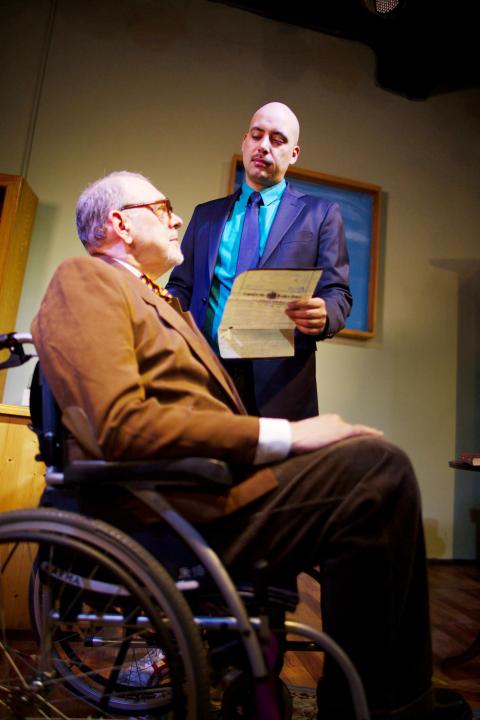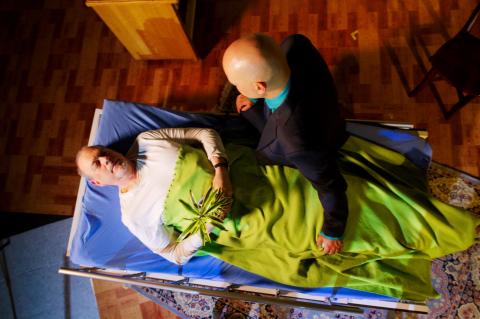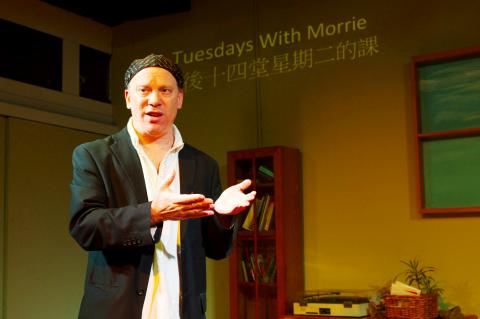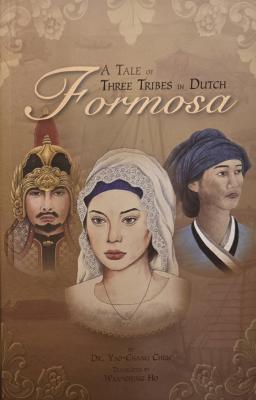Taiwan gained insight into the Latin aphorism ars longa, vita brevis (art is long, life is short) with LAB Space’s recent production of Tuesdays with Morrie. Directed by Taiwan-based impresario Brook Hall, the play, like the well-known memoir of the same name, treats the relationship of sports writer Mitch Albom and his former professor Morrie Schwartz as the latter faces death. Taiwan, however, got more than just a play in that process; it got an intriguing look into the symbiotic relationships that exist between art, life and serendipity.
Start with the book and biography. Certainly, no one will deny how autobiographical and biographical elements can run through art and fiction. Many of Hemingway’s novels, for example, draw both upon his and the life experiences of his friends for background.
The play differs from the book. In drama, since each production varies in director and cast, the impact will also be different. Taiwan’s production of the play had this one extra feature — Rob Schwartz, the son of Morrie Schwartz, attended performances in the last week and stayed to answer audience questions, biographical and otherwise.

Photo courtesy of Tobie Openshaw
Intermixed is serendipity. Rob Schwartz made a point of using that word in one of his answers. Working in Tokyo as Bureau Chief of Billboard Magazine, he learned of Taiwan’s production via a Facebook posting and volunteered to visit. Serendipity played a big part in the writing of the book as well. If Mitch Albom had not been channel surfing at the time he would not have learned of the debilitating condition of Morrie from Ted Koppel’s Nightline. He would also probably not have had the time for the 14 Tuesday visits with Morrie before his death except that Albom’s paper was on strike freeing up his schedule.
For his part, Hall says he was influenced by the book and wanted LAB Space to be known for more than comedies. He also had the constraints of the small theater space requiring plays with a minimal cast and he had in mind a well-known entertainer, DC Rapier, to fit the lead role. Rapier read the book and was moved by both it and the play, but the lines of the play perhaps had more impact since a friend of his had just died and Rapier himself had had a somewhat life-threatening operation. Victor Stevenson, who played Mitch, used the illness and death of his own father to help identify with his role. He and Rapier developed the needed chemistry for the play.
Rob Schwartz brought other elements in. What was it like growing up with his father? How did the family feel about Mitch? When the Schwartz family sold the house made famous by the book, his mother refused to let that be part of the advertisement, though it would have increased the value. A best seller? Several publishers had originally refused the book; it did not take off until Oprah endorsed it. Did that make it art or more what the general public wanted or both? Some people might have liked the book less if they knew of the left wing politics of Rob’s father. That element was purposely left out. And of course there were unrelated questions like, what do you feel about Doraemon?

Photo courtesy of Tobie Openshaw
The book allows for pauses and rereading; the play is bounded by a brief time span for digestion but it is live. Those who had read the memoir could make their own judgments. Rob Schwartz obviously preferred the book; it dealt with his father’s life and thought. This writer preferred the play, perhaps because the drama made the learning and change in Albom’s writing direction more poignant. Having read the book nearly a decade ago, the only specific remembrance is how Albom symbolically brought food that Morrie Schwartz could no longer eat.
Morrie Schwartz died before Albom’s book on his final “class” hit bookshelves; he would never know the full reach of the work and certainly could not have envisioned the play being shown in Taiwan. Life, reality, art, serendipity and memoir; it is all here and the LAB Space as community theater is part of it. For future projects by LAB Space, go to www.facebook.com/labspacetw.

Photos courtesy of Tobie Openshaw

May 11 to May 18 The original Taichung Railway Station was long thought to have been completely razed. Opening on May 15, 1905, the one-story wooden structure soon outgrew its purpose and was replaced in 1917 by a grandiose, Western-style station. During construction on the third-generation station in 2017, workers discovered the service pit for the original station’s locomotive depot. A year later, a small wooden building on site was determined by historians to be the first stationmaster’s office, built around 1908. With these findings, the Taichung Railway Station Cultural Park now boasts that it has

The latest Formosa poll released at the end of last month shows confidence in President William Lai (賴清德) plunged 8.1 percent, while satisfaction with the Lai administration fared worse with a drop of 8.5 percent. Those lacking confidence in Lai jumped by 6 percent and dissatisfaction in his administration spiked up 6.7 percent. Confidence in Lai is still strong at 48.6 percent, compared to 43 percent lacking confidence — but this is his worst result overall since he took office. For the first time, dissatisfaction with his administration surpassed satisfaction, 47.3 to 47.1 percent. Though statistically a tie, for most

Six weeks before I embarked on a research mission in Kyoto, I was sitting alone at a bar counter in Melbourne. Next to me, a woman was bragging loudly to a friend: She, too, was heading to Kyoto, I quickly discerned. Except her trip was in four months. And she’d just pulled an all-nighter booking restaurant reservations. As I snooped on the conversation, I broke out in a sweat, panicking because I’d yet to secure a single table. Then I remembered: Eating well in Japan is absolutely not something to lose sleep over. It’s true that the best-known institutions book up faster

The excellent historical novel by Chen Yao-Cheng (陳耀昌) is a gripping tale of Taiwan in the 17th century, called Formosa at the time, told from the perspective of characters representing the three major ethnic groups (the “tribes” mentioned in the title): the indigenous community, the Dutch and the Chinese. Another element that makes this book stand out is the female perspective, as two of the main protagonists are Maria, the daughter of the Dutch missionary Hambroeck, and Uma, an Aboriginal woman with a strong character. The main Chinese character is Chen Ze, a man in charge of a merchant ship